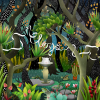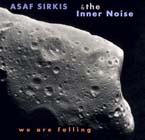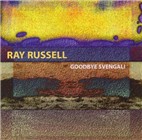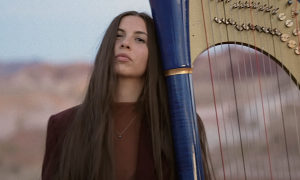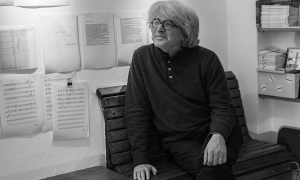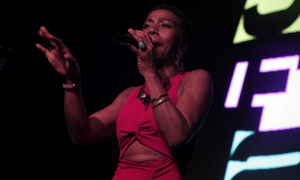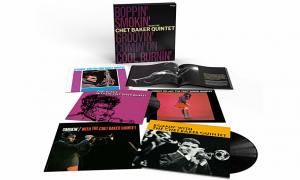Home » Jazz Articles » Interview » Clogs: Opening Up the Possibilities
Clogs: Opening Up the Possibilities
Now you've got something that, well, really sounds nothing like Clogs, the remarkable new-music quartet made up of Padma Newsome (viola/violin/melodica/piano/voice), Bryce Dessner (guitar/ukulele), Rachael Elliott (bassoon/melodica) and Thomas Kozumplik (percussion). The four Clogs met in the late nineties as students of the Yale School of Music and have produced four CDs so far, all on the Brassland label: Thom's Night Out (2001), Lullaby for Sue (2003), Stick Music (2004), and the brand-new Lantern—arguably the group's best effort so far. It's entirely factual to call Clogs a new-music chamber ensemble; this appellation does nothing whatsoever to prepare the listener for their musically-impeccable mixture of composition and improvisation incorporating chamber suppleness, time-signature fearlessness, compositional exploration and accessibility, and plain old beauty. I met with Newsome and Dessner in New York's City Bakery in January to discuss all things Clogs.

Thomas Kozumplik, Rachael Elliott, Padma Newsome, Bryce Dessner
All About Jazz: Both of you come from classical music backgrounds, I believe. I suppose your material can be described as a sort of chamber music, but by dint of composing all your own material, you've stepped outside of any repertory realm of classical or modern composed music. Tell me what got this group together and what your intentions were at that point. Did you have any specific notion of what sort of music you wanted to make?
Padma Newsome: I actually had a dream about this ensemble. The dream was basically stating what kind of approach was right for the ensemble. There were a couple of people I already knew that I was interested in working with. We were almost at the end of our schooling times, actually—and even though we were at school, we were always making music anyhow outside of school, outside of university. So the idea was to work with people who were readers and improvisers, primarily. Also, the music would be our own music. So that's where it started, and the next challenge was finding the right people and actually getting the music up and running—finding the music that would be our own signature. Wait, I'm going to restate that: the function is not to find music that's its own signature, but once you've written a bunch, that music starts to tell you a little bit about the kind of ensemble it needs, or the other music that needs to be written for it. So after about two years, we basically had a sense of what kind of music we liked. Initially, we were just scrounging around for music.
Bryce Dessner: We didn't even organize concerts at the beginning. We just had some rehearsals, and spent a year kind of making stuff up. Padma actually had some stuff written for other things he'd done, so we took some of that and wrote some other new pieces. There's a piece on the first record [Thom's Night Out] called "Sadness and Obsession" that's basically free improv. I was doing a little bit of that free stuff in New York, getting involved with the downtown scene a little bit. Anyway, we kind of collected stuff. Now, after having made the fourth record [the new Lantern], we sort have have defined our own boundaries. Previously, we've gone a little bit poppy, we've gone pretty far into contemporary classical. We've done a concert of Clogs with orchestra, we've done projects with really great improvisers—we've moved around a bit. Now, I feel like we've defined our boundaries. People do look at it like it's a really idiosyncratic kind of band; we don't really fit in anywhere.
AAJ: You certainly don't fit into the record store I was just at. I wasn't sure what category you'd be filed under.
BD: I"ve seen us in "experimental music," I've seen us under "jazz," I've seen us under "new music" listed with the composers. As often as not, it's under "pop"—filed with the rock music.
AAJ: I don't hear outrageous amounts of improvisation in your music, which is only to say that your pieces sound arranged and don't seem designed as vehicles for Rachael Elliott to, say, just blow on bassoon. But when I hear the music, I get the feeling this is the sort of material that develops initially out of group improvisation. That's just my impression. How do you compose?
PN: There's a range of the extent to which the material is composed. There's a range. Sometimes it's a full piece, and sometimes it's only snippets. Actually, you might be a little bit surprised how much is improvised and how much is not improvised. With the new record, I'm always fascinated by how Rachael has managed to do these secondary lines of beauty underneath the soloing instruments of some sort of other—actually, we've reached a notion about improvisation that we've actually spent a couple of years defining. A lot of improvisation is accumulation of ideas already played and then choice. You already know that this material works, because you've improvised it before; you already know its role in a musical organism of some sort. You know what has worked previously.
BD: There are some interesting examples on Lantern. Take "Death and the Maiden." The entire opening—well, it starts with a quote from Schubert, the opening chords on the guitar and the violin melody. But then the entire opening is improvised; it's one take, one long improv. Then the second half of the tune is completely written by Padma; it's scored.
AAJ: That's very distinctly a two-part piece.
BD: It's definitely that. A mix of two types of behavior.
PN: But there are sneaky stealings—there are sneaky stealings in the second part as well. Some of the vertical, some of the chordal material in the second part. We're not afraid to improvise on other people's music, say, from the classical or romantic period. In my mind, I know that Schubert was a huge improviser. You can tell he's one because he wrote two pieces with this one idea. So in my mind, he's drunk at midnight improvising, going "yeah, man, it's so fucking cool, what I did"—so I figure, why can't we use that material in that way?
AAJ: There's that notion about classical repertory that has gotten confused over the last couple hundred years—people now think it's some static material.
PN: The improvisers were incredible. They were amazing. Bach, Schubert—they were amazing improvisers. That's how Beethoven wrote his sonatas, by improvising. Anyone who played the organ as well—anyone who was an organ player and who was writing for organ. You know these guys were spending the first hour of the church service—while everyone's walking in—improvising on their fugures or their ideas. Like Messiaen.
AAJ: Padma is credited for the lion's share of the composing on the earlier Clogs CDs, but on Lantern, all the pieces except the first two are "composed and developed by Clogs." Does this mean that the group's compositional procedures have changed?
BD: Not really. Padma does write the lion's share, and I usually get credit for a few things. Tom and Rachael contribute a lot, but they don't really ever get composition credit. So we kind of just made an egalitarian decision: "let's not stake our claim to this or that; let's credit it all to the band." Nothing's actually changed about the way that we work.
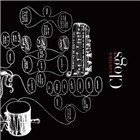 AAJ: The group's spread out geographically; no one lives in the same city. I'm curious as to how that affects your work.
AAJ: The group's spread out geographically; no one lives in the same city. I'm curious as to how that affects your work.PN: It's a big challenge. I mean, once we're in the same place, it's all good. But actually getting to the same place is sometimes difficult. Organizing tours is sometimes difficult. But regardless of any of those things, once we're sitting in that room, we're back to our old selves and learning how to play with each other again and getting excited by each other's playing and so on and so forth.
AAJ: All right, enough small talk. I really want to talk about your new CD Lantern exhaustively. This is your fourth album. Superficially, I suppose this is your electric guitar album, Bryce.
BD: Well, Lullaby For Sue [the group's second album from 2003] has a few electric tracks—at least two, maybe three. But yeah, there are maybe ten electric tracks on this one.
PN: But some of this comes from a situation where you're gigging and you're just sick of picking up three instruments.
BD: I'd also gotten really into electric guitar—playing it a lot in my rock band [The National] and then in a lot of new music settings. There are just so many creative possibilities about it. That said it, in Clogs I play a lot of finger-style electric, so it's classical technique.
AAJ: Well, I don't find it jarringly different from your acoustic work; it seems very much of a piece. The album starts off with a piece by Johann Hieronymus Kapsburger—now, my advance copy calls the song "Kapsburger," but that can't be its title?
PN: I think that's what we called it.
BD: No, on the record it's called "Ostinato."
AAJ: I'll admit to not being familiar with Kapsburger's work, but I will guess that it was composed for lute.
BD: Bass lute.
PN: Beautiful, beautiful instrument, and this was his specialty; he was a virtuoso himself. Sixteenth-century.
AAJ: This one has a guest musician—Luca Tarantino on classical guitar.
BD: A baroque guitar, actually.
AAJ: And Bryce, you're on acoustic and electric?
BD: Just electric. There's an electric and a baroque guitar.
AAJ: I thought I heard two acoustic guitars in there.
BD: The baroque guitar is double-chorused, so that might explain what you heard.
AAJ: Fair enough. Is there any reason you start off this record of mostly originals with someone else's piece?
BD: Yeah, there's an interesting story. That piece was not part of the record for quite a long time. Luca's a musician from Italy that I met and worked with at a festival there, and we invited him for a residency in France last year with a French group that we were collaborating with there. We added Luca to the mix. He's just an amazing, interesting musician. I had been writing some music myself—actually, "Fiddlegree" is from this period of time when I was kind of riffing on Renaissance music and the idea of ornamentation. Padma's also dealt with that a lot in his own music. So Luca showed up with this piece and said, "I want you to hear this." He called it baroque minimalism. Because, you know, I did a tour with Philip Glass around this time and was reacting a little bit to that music.
So basically, this song is a set of chords and that's all it is; it's not written out. It's not at all done as a period piece—we did it in a weird way. Electric guitar, the arrangement is totally out, I'm playing these harmonies over Luca. So they sent us the recording from France probably eight or nine months after we did it—it's a live recording, one take—and I thought it was such a lovely opening. And somehow it made everything else on the record make more sense. There's already the Schubert quote on the record and there's this other music we were relating to.
PN: We felt the record was too poised in a way. It felt very poised, so we chucked these others in and it opened the whole record up.
BD: Yeah, it felt like a great opening to me.
PN: Let's go back to what that piece is in its actuality. It's a chord chart. That's it. So there would have been ways they played that that probably we don't know about. But it's an improvising piece. There are lots of ways you could actually play that.
AAJ: There would be almost infinite ways, wouldn't there?
PN: Well, there might have been a manner in which one should be playing it. And probably Luca is doing it in that fashion, basically stating the chords in an arpeggiated fashion. And that's an interesting link between that period and now, and jazz for example. Early in the seventeenth century, they invented a way of notating chords—figured bass, it's called.
AAJ: "The Song of the Cricket" is a song I like very much. The strings and bassoon sound oddly effected on this one and I suppose they're building over Bryce's guitar vamp in a long, slow crescendo. They're very ghostly, and when your guitar joins into that crescendo it's almost Sonic-Youthish. Then there's that sprightly little ethnic coda that finishes this one off. Any insights?
PN: Two ideas, you know. I thought of the piece, especially the opening material, when I was just sitting down in Red Hook in Brooklyn. It's kind of desolated, dilapidated old port, or was at that time—now they're turning it into gardens. But I was just sitting there by myself late one night, just listening to this cricket, and I had this weird kind of idea: what does a cricket actually sound like to itself? This generated the idea that maybe it thinks it's making some fabulous, symphonic epic thing. Then the last section is just a silly little coda—humorous coda.
AAJ: "Canon" is composed by you and Charles-Eric Charrier and Rasim Biyikli, who are the duo Man. They don't play on it, though. This piece has drums—or rather, drum—melodica, electric guitar. Basically a vamp of sorts is repeated until a melodica, who I assume for some reason is Rachael—
PN: I'm playing that this time, actually.
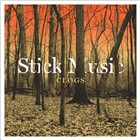 AAJ: Anyway, that melodica gives us that melody. I think there's a bassoon in there as well. This one seems all about repetition and layering of a great depth of instruments that rise and subside in the foreground and background.
AAJ: Anyway, that melodica gives us that melody. I think there's a bassoon in there as well. This one seems all about repetition and layering of a great depth of instruments that rise and subside in the foreground and background.
BD: That came out of that same period that "Kapsburger" did, when Luca was there. We were working with this group Man. The bass line [sings it]—that's the canon. So it's another kind of classical behavior where we're layering, like a canon, around. That bass line is written by this French bassist, Charles, and Padma wrote the melodies over it. It's the kind of music that Clogs actually hasn't done much of; a very repetitive, almost more rock behavior with a drum beat.
PN: It's a huge drum he's using.
BD: Big concert bass drum, yeah.
PN: If you get to hear this in a room with very cool speakers you can hear a lot of stuff going with—the skin.
BD: When we play that piece, it's really one piece with the next piece on the record, which is called "5/4." They're always played together. Again, kind of two sections. What's interesting about the bass line of "Canon" is that that bass line was written by Charles, the French guy—it's written to "Swarms," which is another Clogs piece from Lullaby For Sue. It's a kind of minimalist piece in five. So he actually composed that bass line to one of our other songs and then we created a new piece out of it.
AAJ: I find "2:3:5" pretty difficult to describe. It sounds like a Clogs piece, and there's chiming electric guitar, bassoon and strings, but it's not really definable to me. I do think it's got a looming sadness that turns pretty ecstatic towards its end and I believe it's constructed of instruments repeating phrases that interlock with each other—they sort of drift onstage and then wander off. How is a song like this put together?
PN: We were touring one of these endless rock tours [with The National], Bryce and I, and we were at a horrible pit stop in the middle of nowhere somewhere. Bryce comes up to me and says, "what would this ratio sound like?" The 2:3:5. We went away and we thought about it and I took Bryce for a walk. We were walking the fives and clapping the twos and the threes—and then we forgot about it. But I went back to Australia and realized that this is actually not a difficult rhythm and that a single instrument can do this rhythm if we put it in 5/4. So I found some very simple ways of playing it, very simple left-hand behavior. [To BD:] Right?
BD: Yes. The guitar plays this ratio and there are three rhythms in each measure. So if you listen to it, you can either feel the five, the three or the two, based on the notes. So we built a piece out of that. And you're right—I would say it has minimalist characteristics due to that layering of rhythms. But there's also quite a lot of improv—the steel drum, the violin and the bassoon. And then there's a vibes part.
PN: There's a stop—the vibes comes in with the "dum-dum-dum."
BD: Yeah, the end of the piece changes meter; it goes into three.
PN: And we top-and-tailed the rhythm; took the first beat off and the last beat off and it's in a 3/4, so it's still the same rhythm—it's just top-and-tailed. I think that's a pretty important piece for us, just, you know, in our gigging and how we felt about that and what that meant in our central repertoire. It turned us a little bit in another direction, I think, and we really enjoyed playing it during that period prior to the record when we were touring in Europe.
AAJ: A piece like that that incorporates a fair bit of improvisation—do you find that it's mutating slowly in performance?
BD: It's different every time. The piece is not difficult; it's not very hard, it's very much a grooving piece. It depends on listening and communication. We have other pieces which are much harder to play. But certain solos will bloom. I'm kind of the bassist in that piece, and I decide when it starts and when it ends.
AAJ: "Death and the Maiden"—another two-part piece.
BD: Right, the one we talked about with the Schubert quote.
AAJ: Yep. The first part is almost a duet between the two of you—Padma, you're on violin here. But there's some one-note bassoon sort of groaning in. This part is pretty Romantic'"there's vibrato on the violin. My notion when I heard it was that that was improvised, and now I know that's true, since you already told me.
PN: Right, the tune [singing it] is Schubert. Anything else is a mutation of that or an extemporization.
AAJ: Now, for the second part, Thomas's percussion enters and the piece turns into a polyrhythmic, knotty sort of hoedown. I'm not sure if everyone is playing in the same time here.
PN: It's all subdivisions of the sixteenth-note. I'm the one who's keeping the one; my G string is always stating the one. Over the top of that, Bryce is doing groups of seven. When the bassoon and drum come in [taps the table], there's a three. So everything is subdivisions of the sixteen.
BD: What were we calling it? "Chamber trance." It ended up being a little more—well, it is a little more hoedown. It's more intense than just trance. It's not like electronic music, or even some of Steve Reich's pieces, which are kind of flat dynamically. That piece, I think, is much more ripping. Maybe it reminds me more of [Estonian composer] Arvo Pärt or something.
PN: I think if you changed the instrumentation to synthesizers, you'd get it sounding like trance. There's something about the acoustic nature of the threes.
BD: Yes, and there's the imperfection of the way we play it—it's not perfect. Which I think is a quality which we like. There's a vitality to the rhythm. When you layer rhythms like that which are actually kind of impossible to play perfectly on top of each other, it gets this kind of tension.
AAJ: I love the sounds of bassoon and oboe so much that it restricts my ability to criticize the players of these instruments. But I love Rachael Elliott's bassoon playing. I think her greatest moment on Lantern might be the song "Compass"—in any case, it's nice to hear her play all over the horn like she does on that one. I love her terseness as a player; she never seems to play more than the necessary note. Tell me what she adds to the group's music.
PN: She's a very fine player. And a good bassoon player who's an improviser—an inventor of music—is kind of a rare creature. So we're very lucky to be working with her.

Padma Newsome, Bryce Dessner
BD: She is a very understated person as well. She puts her will in last; she's the last person always, but she's very quiet and observant. She's extremely musical. She's got lots of skills that you wouldn't know: she's a good keyboard player, she's got perfect pitch. You know, that instrument is just unwieldy to play; it's extremely difficult. She's got great embouchure. She's always in tune.
PN: The last tour we did, when we were touring up north with Belle Orchestra—I heard [a recording of] the Boston gig. In one of them, I think "2:3:5," I'm supposed to be soloing. After hearing myself play, and hearing Rachael's fabulous playing—it was a real eye-opener. I thought, "it's so beautiful, her playing. I should shut up more." [laughing]
AAJ: In the same vein, let's talk about your percussionist Thomas Kozumplik. I particularly like his playing on "Voisins." He's capable of such intricacy and he's got such a lovely feel. Give me an appraisal of his contribution to Clogs.
PN: He's very thinking. So if he is given material to work with, there might be suggestions: "this material might be skins, this material will be metals, this material will be wood." There might be a suggestion like that, in the way one of us might have thought when we were writing it. So he will go away and he will invent a way, an organic way of fusing those together and that requires a lot of time in his room choosing instruments. Very carefully-selected instrumentation. Then he has to learn to make his body do the fused rhythms.
BD: He's really careful about his choice of sounds. He thinks about it like crazy. He's one of these percussionists who practices like twelve hours a day and really cares. He's a very serious musician. He's always played a lot of different kinds of music; his education is really percussion-ensemble playing, a lot of contemporary music like [Iannis] Xenakis and [Paul] Hindemith—all those percussion-ensemble pieces. But he's played jazz and rock stuff. Whenever we present a piece, it takes him hours to even play a note. He's thinking.
PN: It's kind of scary when you present a new piece.
BD: That way he's very different from the normal drummer. A normal drummer will sit down and start banging.
AAJ: It unnerves musicians when someone isn't playing. It can be interpreted as surliness.
BD: Yeah. In his case, we know it isn't.
AAJ: No song is more beautiful than "Lantern." I love the idea of Padma singing one song per CD—which isn't to say this is a strict rule. Somehow when there's only one vocal track, it gives that track a remarkable presence due to its being, as on this new CD, right in the middle of the record. I like the steel drum melody and Bryce's guitar, and it's very nice that when Padma sings the melody, he and Rachael have already played that melody on their instruments. The vocal ends up being the last word on the subject. Padma, you wrote the lyrics?
PN: On that song, yeah. I don't know what to say about that song—I like it too. It was written in Mallacoota [in Victoria, Australia]. I have a lot of nostalgia [laughing] for anything I write in Mallacoota for some reason or other. It seems like when I'm looking for material there, it's not sophisticated. It's pared down, an idea in its simplest form. I do like the piece.
BD: A lot of ideas come from songs. Padma writes a lot of songs. There's only one on each Clogs record, but it's not by choice. There might be other pieces we've done that had songs in them. I think it's a really nice thing that there's this voice that comes out. Rachael has also sung a bit in the past; there's a song on the first record that has singing with no words—"I'm Very Sad."
PN: It's nice in a concert, too. People aren't expecting it and all of a sudden it opens out into a song, a sweet and sad song.
BD: It invites people in much closer.
AAJ: I'm not really one for inquiring what lyrics mean, but I will say that that phrase "light me a lantern by your lighthouse, my keeper" is extremely moving to me when I hear it.
PN: The Gabo Isle is a symbol for where I live. There's an island there with a lighthouse on it. I don't mean to personalize it too much, but everybody has their home.
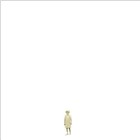 AAJ: Tell me about the song "Fiddlegree."
AAJ: Tell me about the song "Fiddlegree."BD: "Fiddlegree" is another fun piece, like "Cricket." It's got a little bit of humor in it. It's played on a ukulele, a tenor ukulele I bought in California, which is actually very nice—a concert uke. I originally wrote the material on the guitar. The name comes from "filigree." I think I was reacting at the time to a few things. One was the lack of detail in a lot of contemporary music, especially minimalist music—the lack of ornament or subtlety. As a player, when you're playing tht kind of music, you very much lose your sense of individuality. So on the song you start off with these kinds of ornaments; Padma and I play those together. We're improvising. It's a heavily improvised piece.
PN: Very free.
BD: Very free. There are kind of scalar passages [sings the repeating phrase] which is kind of a loose quote on a Philip Glass piece called "Music in Fifths." I'd just gotten off of playing "Music in Fifths," which is a thirty-minute piece—with him, actually, which is just amazing, but mind-boggling to have to follow that line exactly with six players. So it's kind of like, well, ghost this scale but do whatever you want. And then the ending makes it all a palindrome. It's these little intellectual ideas that kind of hide in these pieces.
PN: Just going back to that idea of intellectualism in the music—I'm personally of the belief that some kind of mental restriction or bind actually binds us to the music in a stronger sense. Then as a player or writer of music, the assumption would be that if we are bound to the music and we feel more strongly about it, then that's going to reflect in some way in the way the music is received. That would be one of the theories behind doing something. It's not outwardly obvious that there is a palindrome there, but there's a sense that there is something there and that there is a kind of tension about the way the performers are playing it, or trying to play it as adequately as possible.
AAJ: The intellectualisms add a structural rigor?
PN: Yeah, but I don't think structural rigor in itself is a good thing necessarily. Or a bad thing.
BD: It's a small piece. It's kind of delicate, it's got quiet instruments. It's an attempt to create a delicate kind of music which I think was successful in a way. It's sort of like a toy piano piece. It has that levity live. It's also strangely upbeat live; it's quick, up-tempo. What's funny is that my sister finds it very sad—the opening and the melodica line.
PN: For that piece, I'm often sitting on the floor with a pen or something doing the rhythms. It's fiddly. Intimate.
AAJ: Interesting how the audience reaction to a piece you play can tell you what emotional content it has before you might know.
PN: We're just happy to go with the audience's response. "Well, okay, they liked this." And I think that's the reason why we kept playing it and kept it elegant, because people had a pretty unanimous response to that piece.
AAJ: Okay, tell me about "Tides of Washington Bridge." This effectively appears twice on the record—the album ends with "Tides (Piano)," which is the same melody played on piano.
PN: That's pretty much a composed piece. There are some spaces made between the main formal chunks where we open out a little bit and there are textural changes and things that we do that are free. That was written in two places, actually. One was this huge, long trip across the north—we were driving from something like Minneapolis to Maine. Something ridiculous in one hit.
AAJ: I hope you didn't have a show scheduled in each place as consecutive tour stops.
PN: We did, yeah. That's normal behavior. And there was a melodic line [sings it] which came out of that, just rolling around in my head. And I liked the idea that we could modulate to another place without us knowing we'd gone there because it's the nature of the melodic line. Then, all the chordal material came after that. For that, I was staying at a friend's place—Daniel Bacon, he's a sound designer. He works with theater and he's done some engineering for us over the years. I was staying at his place up in Washington Heights, listening to the sound of the traffic going across the bridge. Of course I got the name wrong, because I'm stupid [laughing]—it's George Washington Bridge, so it's "Tides of Washington Bridge." It reminded me of the sound of waves.
BD: The piece comes out of the same kind of obsession with ornament and that residency with Luca, the Italian guitarist. When Padma wrote the piece, the original arrangement had an ornamental, baroque guitar part, a kind of filigree. So we played it once like that.
PN: Which is quite sweet, especially when Luca's playing it.
BD: Then [Padma] played it on piano, just kind of ripping in the studio on this great nine-foot grand that they had, and it sounded so good that it had to go on.
PN: They didn't even know that I'd done it. I was there and I saw the grand piano before they arrived. I thought, "fuck this, we have to have the grand piano in this record."
AAJ: It's a very nice way to end the record. Did you put much thought into the sequencing of this album?
BD: Yeah.
PN: Yeah. Endless.
BD: I'll take credit for the version you're hearing. It's kind of me alone, obsessing over it. And I added the extra tracks.
AAJ: Well, you want the record to be as successful as possible.
BD: Yeah, and it wasn't. We had a version—the record was finished a year ago in January. We had a sequence pretty soon after and it wasn't quite right.
PN: It was too poised.
BD: The Kapsburger piece, and then "Compass" are late additions. The record used to start with "2:3:5," which wasn't quite working.
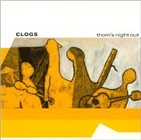 AAJ: I'm bemused the descriptions of Clogs I read when I was getting ready for this interview—all the other groups that you're compared to. It's so wildly all over the place. This probably indicates your dissimilarity to anything else out there. Personally, in terms of other artists you resemble or evoke, I think most of Oregon, just due to the instrumental lineup and flexibility—certainly more than, say, Godspeed You Black Emperor.
AAJ: I'm bemused the descriptions of Clogs I read when I was getting ready for this interview—all the other groups that you're compared to. It's so wildly all over the place. This probably indicates your dissimilarity to anything else out there. Personally, in terms of other artists you resemble or evoke, I think most of Oregon, just due to the instrumental lineup and flexibility—certainly more than, say, Godspeed You Black Emperor.BD: Well, Ralph Towner is my favorite guitarist ever. I feel like Oregon got unfairly thrown into the new age camp, which is a reference that we, obviously, really don't like. I would also say we've also steered away from any kind of mainstream jazz. We've played on the London Jazz Festival and we've played shows with jazzers. But we don't improvise in that style. We don't play licks. We're really careful about avoiding style quotes.
AAJ: Well, I don't care much about categories, but I would say that you do not play jazz music. Nor do I think you sound that much like Oregon—just more than some of the other bands you're compared to.
PN: I want to go back and say something. I don't want to sound negative about new age music. It's its own thing and it does its own thing. I think it's wrong to describe us as new age, but there's a lot of beautiful new age music. Some of my composer friends have actually dabbled in it as well. My issue with it is the lack of musical information.
BD: I have a problem with it, but we can disagree. I feel it's a blatant commercial attempt. It's something that sold well in the eighties, and so everyone that can play an instrument jumps on that bandwagon.
AAJ: I think it's pretty bad. I like ambient music, and those genres intertwine, but with new age there's no meat there.
PN: Yeah. At the massage parlors, I always make them turn off the music. I say, "no music, please."
AAJ: Who are your musical influences—anyone you think is particularly influential?
PN: I couldn't even begin. I love so much of twentieth-century contemporary—I don't even like the term "classical"—classical music. There's so many wonderful composers from that period. I go way back with my loves. My loves with rock are generally unnamed loves, because I have such a bad memory for names.
BD: I get little obsessions. I would say [legendary minimalist composer] Moondog is someone I'm really interested in. John Cage is somebody that we both like and if Clogs is a lineage that goes back, it might be coming somewhere from him, just in terms of his opening up the possibilities of what is concert music. There's groups like the Penguin Café Orchestra that people have compared us to, and I think that's not a bad comparison. Like I said, Ralph Towner is a big influence on my guitar playing. We're as influenced by some contemporary composers like Reich or Bartók as we would be by the medieval stuff we were talking about or Renaissance music. We kind of glean things from everywhere and we're active in a rock band [The National] so we're constantly hearing tons of rock bands.
PN: People talk a lot about minimalist techniques. A lot of those minimalist techniques come from the Ars Nova period, [French poet/composer Guillaume] de Machaut, fourteenth century. That stuff is still fascinating to me. Even Bach, the way Bach generates material, is fascinating to me. I still like turning things on their head, turning things backwards, weird little tricks like that. Maybe and hopefully, people don't even know I'm doing it. I'll still do them just to play and try to find consonances and rhythms that are interesting. No, not interesting—attractive.
AAJ: Who are your fans?
PN: I think we have five.
BD: I would say they like experimental music. Some rock people have discovered Clogs.
PN: We don't know, because they'll just turn up. Like Clogs fans that turn up at National gigs and have traveled a thousand miles.
BD: Some musicians. I think we've made a little bit of a mark among the kind of grad school conservatory type—classical musicians with an open mind. They tend to look at it and think, "oh, this band's done something, made a little bit of a contribution in terms of opening the doors a bit wider for concerts."
PN: We complement that ground, too. The part about that ground is classical music, so we're often meeting people who say, "I'm a grad student, I'm trying to form a band that would play at cross-style venues." So we hear stories like this.
BD: We played Chicago, and we were the pick in the Reader [Chicago's free weekly] that week. We played this cool little converted church [3030], a performing space there—since gone. A collective. A cool place, no bar, church pews.
PN: Yeah, they were a collective and we get a lot of collectives interested in us.
BD: This was a real improvisers' place. More jazz dates, I'd say. And it was full of people, just kind of music heads. I don't know who they were.
Tags
PREVIOUS / NEXT
Support All About Jazz
 All About Jazz has been a pillar of jazz since 1995, championing it as an art form and, more importantly, supporting the musicians who make it. Our enduring commitment has made "AAJ" one of the most culturally important websites of its kind, read by hundreds of thousands of fans, musicians and industry figures every month.
All About Jazz has been a pillar of jazz since 1995, championing it as an art form and, more importantly, supporting the musicians who make it. Our enduring commitment has made "AAJ" one of the most culturally important websites of its kind, read by hundreds of thousands of fans, musicians and industry figures every month.


